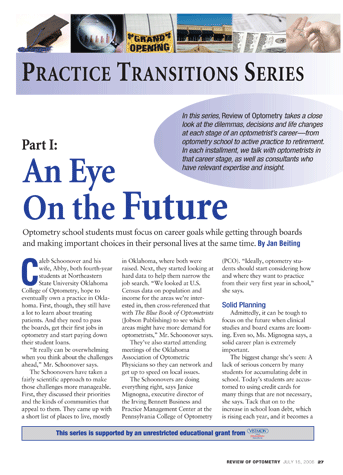About this time last year, I was at the AOAs annual congress, having lunch with an eager, young optometrist who wanted to write for Review of Optometry. He wanted to share how he faced the many challenges of starting his own practice just a few short years after graduation.
Later that day, I had dinner with a much more seasoned O.D. who, to put it mildly, was simply disgusted with private practice. Dont get me wrong; he was just as eager as his greener counterpart. However, his energy wasnt focused on building a practice. On the contraryhe wanted to unload his practice.
These stories arent revolutionary or surprising, nor is there anything unique about either optometrists tale. Even so, theres much value in both because almost every optometrist can relateand will find himself or herself at the same crossroads at some point in the future. I decided that day that stories such as these needed to be told.
But how? And, what about all the events and challenges that you face between optometry school and retirement? Enter the ever-brilliant John Potter, O.D. Lucky for my waistline, he didnt divulge his story idea over yet another mealalthough his fantastic idea certainly earned him a good one, on me.
Dr. Potter was brainstorming with fellow Review board members on content for the 2006 editorial calendar when he suggested a series that would highlight the various stages of an optometrists careerfrom optometry school through retirement.
The editors loved the idea and made a commitment to launch it. Not long after, industry also jumped in to support it. Vistakon offered an unrestricted education grant to produce a six part series!
 |
Practice Transitions Practice Transitions Series, An Eye on the Future, by Jan Beiting. In it, youll follow fourth-year students and hear from Janice Mignogna, executive director of the Irving Bennett Business and Practice Management Center at the Pennsylvania College of Optometry (PCO). |
This month marks Part I, the student years, when future O.D.s make decisions that will affect the rest of their lives. Next month, Part II will focus on the first five formative years of practice. Part III will highlight practice years five to 15, when many O.D.s establish specialties and become more involved in leadership, research and publishing. Part IV will look at the challenges of practice years 15 to 25, when many O.D.s may have outgrown their first practice and are ready to purchase a second building or larger building. Part V will spotlight practice years 25 to 35 and will focus on important considerations when planning for retirement. Finally, in December, Part VI will highlight selling a practice and embarking on retirement.
The goal of the series is to help you prepare for each new stage in your professional career. Mean-while, Im off to the AOA meeting to meet with the Review board about next years calendarand to offer Dr. Potter a long-overdue invitation to lunch.

